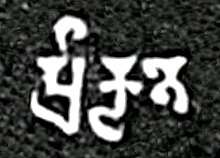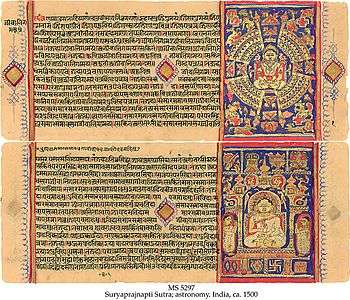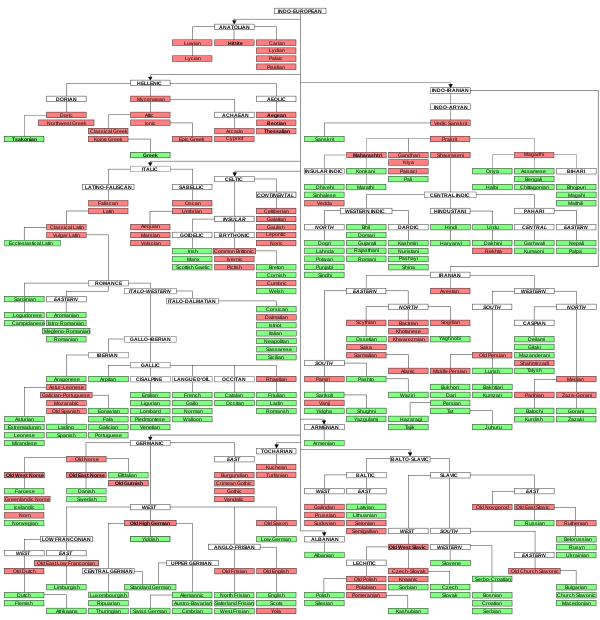Prakrit
The Prakrits (/ˈprɑːkrɪt/; Early Brahmi Sanskrit: 𑀧𑁆𑀭𑀸𑀓𑀾𑀢, prākṛta;[5] Devanagari Sanskrit: प्राकृत, prākṛta; Shauraseni: pāuda; Jain Prakrit: pāua; Kannada: pāgada) are a group of vernacular Middle Indo-Aryan languages used in India from around the 3rd century BCE to the 8th century CE.[6][7] The term Prakrit is usually applied to the middle period of Middle Indo-Aryan languages, excluding earlier inscriptions and the later Pali.[8] The Prakrits were used contemporaneously with the prestigious Classical Sanskrit of higher social classes.[9] Prākṛta literally means "natural", as opposed to saṃskṛta, which literally means "constructed" or "refined".[8]
| Prakrit | |
|---|---|
| Geographic distribution | Indian subcontinent |
| Linguistic classification | Indo-European
|
Early form | |
| ISO 639-2 / 5 | pra |
| Glottolog | None midd1350 (Middle Indo-Aryan)[3] |
 | |
Etymology
According to the Prākrṭa Prakāśa, an ancient Prakrit grammar, "Saṃskṛtam is the prakṛti (source) - and the language that originates in, or comes from, that prakṛti, is therefore called prākṛtam." The same definition is also given by the Prakrit grammarian Acharya Hemachandra in his grammar of Prakrit.[10] The dictionary of Monier Monier-Williams (1819–1899), however, interprets the word in the opposite sense: "the most frequent meanings of the term prakṛta, from which the word "prakrit" is derived, are "original, natural, normal" and the term is derived from prakṛti, "making or placing before or at first, the original or natural form or condition of anything, original or primary substance". In linguistic terms, this is used in contrast with saṃskṛta, "refined".
Definition


Modern scholars have used the term "Prakrit" to refer to two concepts:[11]
- Prakrit languages: a group of closely related literary languages
- the Prakrit language: one of the Prakrit languages, which alone was used as the primary language of entire poems
Some modern scholars include all Middle Indo-Aryan languages under the rubric of 'Prakrits', while others emphasize the independent development of these languages, often separated from the history of Sanskrit by wide divisions of caste, religion, and geography.[12]
The broadest definition uses the term "Prakrit" to describe any Middle Indo-Aryan language that deviates from Sanskrit in any manner.[13] American scholar Andrew Ollett points out that this unsatisfactory definition makes "Prakrit" a cover term for languages that were not actually called Prakrit in ancient India, such as:[14]
- the language of Ashoka's inscriptions
- the language of later inscriptions of India, labeled "Monumental Prakrit", "Lena Prakrit", or "Stupa dialect"
- the language of inscriptions of Sri Lanka, labeled "Sinhalese Prakrit"
- Pali, the language of the Theravada Buddhist canon
- the Buddhist Hybrid Sanskrit
- Gandhari, the language of birch-bark scrolls discovered in the region stretching from northwestern India to western China
According to some scholars, such as German Indologists Richard Pischel and Oskar von Hinüber, the term "Prakrit" refers to a smaller set of languages that were used exclusively in literature:[14]
- Scenic Prakrits
- These languages are used exclusively in plays, as secondary languages
- Their names indicate regional association (e.g. Shauraseni, Magadhi, and Avanti), although these associations are mostly notional
- Primary Prakrits
- These languages are used as primary languages of literary classics such as Gaha Sattasai
- This includes the Maharashtri Prakrit or "Prakrit par excellence", which according to Dandin's Kavya-darsha, was prevalent in the Maharashtra region, and in which poems such as Ravana-vaho (or Setubandha) were composed.
According to Sanskrit scholar A. C. Woolner, the Ardhamagadhi (or simply Magadhi) Prakrit, which was used extensively to write the scriptures of Jainism, is often considered to be the definitive form of Prakrit, while others are considered variants of it. Prakrit grammarians would give the full grammar of Ardhamagadhi first, and then define the other grammars with relation to it. For this reason, courses teaching 'Prakrit' are often regarded as teaching Ardhamagadhi.[15]
Grammar
Medieval grammarians such as Markandeya (late 16th century) describe a highly systematized Prakrit grammar, but the surviving Prakrit texts do not adhere to this grammar.[16] For example, according to Vishvanatha (14th century), in a Sanskrit drama, the characters should speak Maharashtri Prakrit in verse and Shauraseni Prakrit in prose. But the 10th century Sanskrit dramatist Rajashekhara doesn't abide by this rule. Markandeya, as well as later scholars such as Sten Konow find faults with the Prakrit portions of Rajashekhara's writings, but it is not clear if the rule enunciated by Vishvanatha existed during Rajashekhara's time. Rajashekhara's himself imagines Prakrit as a single language or a single kind of language, alongside Sanskrit, Apabhramsha, and Paishachi.[17]
German Indologist Theodor Bloch (1894) dismissed the medieval Prakrit grammarians as unreliable, arguing that they were not qualified to describe the language of the texts composed centuries before them.[16] Other scholars such as Sten Konow, Richard Pischel and Alfred Hillebrandt, disagree with Bloch.[18] It is possible that the grammarians sought to codify only the language of the earliest classics of the Prakrit literature, such as the Gaha Sattasai.[17] Another explanation is that the extant Prakrit manuscripts contain scribal errors. Most of the surviving Prakrit manuscripts were produced in a variety of regional scripts, during 1300-1800 CE. It appears that the scribes who made these copies from the earlier manuscripts did not have a good command of the original language of the texts, as several of the extant Prakrit texts contain inaccuracies or are incomprehensible.[16]
Prakrita Prakasha, a book attributed to Vararuchi, summarizes various Prakrit languages [19]
Prevalence
Prakrit literature was produced across a wide area of South Asia, from Kashmir in the north to Tamil Nadu in the south, and from Sindh in the west to Bengal in the east. Outside India, the language was also known in Cambodia and Java.[20]
Prakrit is often wrongly assumed to have been a language (or languages) spoken by the common people, because it is different from Sanskrit, which is the predominant language of the ancient Indian literature.[21] Several modern scholars, such as George Abraham Grierson and Richard Pischel, have asserted that the literary Prakrit does not represent the actual languages spoken by the common people of ancient India.[22] This theory is corroborated by a market scene in Uddyotana's Kuvalaya-mala (779 CE), in which the narrator speaks a few words in 18 different languages: some of these languages sound similar to the languages spoken in modern India; but none of them resemble the language that Uddyotana identifies as "Prakrit" and uses for narration throughout the text.[21]
Literature
Literary Prakrit was among the main languages of the classical Indian culture.[23] Dandin's Kavya-darsha (c. 700) mentions four kinds of literary languages: Sanskrit, Prakrit, Apabhramsha, and mixed.[24] Bhoja's Sarasvati-Kanthabharana (11th century) lists Prakrit among the few languages suitable for composition of literature.[23] Mirza Khan's Tuhfat al-hind (1676) names Prakrit among the three kinds of literary languages native to India, the other two being Sanskrit and the vernacular languages. It describes Prakrit as a mixture of Sanskrit and vernacular languages, and adds that Prakrit was "mostly employed in the praise of kings, ministers, and chiefs".[25]
During a large period of the first millennium, literary Prakrit was the preferred language for the fictional romance in India. Its use as a language of systematic knowledge was limited, because of Sanskrit's dominance in this area, but nevertheless, Prakrit texts exist on topics such as grammar, lexicography, metrics, alchemy, medicine, divination, and gemology.[26] In addition, the Jains used Prakrit for religious literature, including commentaries on the Jain canonical literature, stories about Jain figures, moral stories, hymns and expositions of Jain doctrine.[27] Prakrit is also the language of some Shaiva tantras and Vaishnava hymns.[20]
Besides being the primary language of several texts, Prakrit also features as the language of low-class men and most women in the Sanskrit stage plays.[28] American scholar Andrew Ollett traces the origin of the Sanskrit Kavya to Prakrit poems.[29]
Some of the texts that identify their language as Prakrit include:
- Hāla's Gaha Sattasai (c. 1st or 2nd century), anthology of single verse poems[28]
- Ananda-vardhana's now-lost God of Five Arrows at Play, poem[28]
- Sarvasena's Hari-vijaya (late 4th century), epic[26]
- Pravarasena II's Ravana-vaho (early 5th century), epic[26]
- Palitta's Tarangavati (probably 1st or 2nd century), fictional romance[26]
- Palitta's Brilliance of the Connoisseurs[30]
- Haribhadra's Samaraditya-charitra (c. 8th century), fictional romance[26]
- Uddyotana's Kuvalaya-mala (779 CE), fictional romance[31]
- Kautuhala's Lilavati or Kouhala's Lilavai (c. 8th century), fictional romance[26]
- Madhuka's Hara's Belt (10th century), a compendium covering a wide range of topics, such as casting love spells and treating snakebites
- Jineshvara's Treasury of Gatha-Jewels (1194), anthology of verses[20]
- Addahamana's Sandesha-rasaka (13th century), a message poem; the author states that his family came from "the land of the Muslims", which suggests that Addahamana is the Prakrit variant of `Abd ur-Rahman.[20]
Some 19th-20th century European scholars, such as Hermann Jacobi and Ernst Leumann, made a distinction between Jain and non-Jain Prakrit literature. Jacobi used the term "Jain Prakrit" (or "Jain Maharashtri", as he called it) to denote the language of relatively late and relatively more Sanskrit-influenced narrative literature, as opposed to the earlier Prakrit court poetry. Later scholars used the term "Jain Prakrit" for any variety of Prakrit used by Jain authors, including the one used in early texts such as Tarangavati and Vasudeva-Hindi (Wanderings of Vasudeva). However, the works written by Jain authors do not necessarily belong to an exclusively Jain history, and do not show any specific literary features resulting from their belief in Jainism. Therefore, the division of Prakrit literature into Jain and non-Jain categories is no longer considered tenable.[32]
List of Prakrits
The languages that have been labeled "Prakrit" in modern times include the following:
- Apabhraṃśa
- Ardhamagadhi
- Dramili
- Elu
- Gandhari
- Kamarupi
- Magadhi
- Maharashtri
- Paishachi
- Pali
- Shauraseni
Not all of these languages were actually called "Prakrit" in the ancient period.[14]
Dramatic Prakrits
Dramatic Prakrits were those that were devised specifically for use in dramas and other literature. Whenever dialogue was written in a Prakrit, the reader would also be provided with a Sanskrit translation. None of these Prakrits came into being as vernaculars, but some ended up being used as such when Sanskrit fell out of favor.[33]
The phrase "Dramatic Prakrits" often refers to three most prominent of them: Shauraseni, Magadhi Prakrit, and Maharashtri Prakrit. However, there were a slew of other less commonly used Prakrits that also fall into this category. These include Prachya, Bahliki, Dakshinatya, Shakari, Chandali, Shabari, Abhiri, Dramili, and Odri. There was a strict structure to the use of these different Prakrits in dramas. Characters each spoke a different Prakrit based on their role and background; for example, Dramili was the language of "forest-dwellers", Sauraseni was spoken by "the heroine and her female friends", and Avanti was spoken by "cheats and rogues".[34]
Status
Prakrit languages held a lower social status than Sanskrit in ancient India. In the Sanskrit stage plays, such as Kalidasa's Shakuntala, high-class male characters typically speak Sanskrit, while the low-class male characters and most female characters typically speak Prakrit.[28]
Mirza Khan's Tuhfat al-hind (1676) characterizes Prakrit as the language of "the lowest of the low", stating that the language was known as Patal-bani ("Language of the underground") or Nag-bani ("Language of the snakes").[25]
While Prakrits were originally seen as 'lower' forms of language, the influence they had on Sanskrit - allowing it to be more easily used by the common people - as well as the converse influence of Sanskrit on the Prakrits, gave Prakrits progressively higher cultural cachet.[35]
Among modern scholars, Prakrit literature has received less attention than Sanskrit. Few modern Prakrit texts have survived in modern times, and even fewer have been published or attracted critical scholarship. Prakrit has not been designated as a classical language by the Government of India, although the earliest Prakrit texts are older than literature of most of the languages designated as such. One of the reasons behind this neglect of Prakrit is that it is not tied to a regional, national, ethnic, or religious identity.[30]
Research institutes
In 1955, government of Bihar established at Vaishali, the Research Institute of Prakrit Jainology and Ahimsa with the aim to promote research work in Prakrit.[36]
The National Institute of Prakrit Study and Research is located in Shravanabelagola, Karnataka, India.
References
- William Bright (2014). American Indian Linguistics and Literature. Walter De Gruyter. pp. 16–17. ISBN 978-3-11-086311-6.
- Alfred C. Woolner (1986). Introduction to Prakrit. Motilal Banarsidass. pp. 3–4. ISBN 978-81-208-0189-9., Quote:"If in 'Sanskrit' we include the Vedic language and all dialects of the Old Indo-Aryan period, then it is true to say that all the Prakrits are derived from Sanskrit. If on the other hand 'Sanskrit' is used more strictly of the Panini-Patanjali language or 'Classical Sanskrit,' then it is untrue to say that any Prakrit is derived from Sanskrit, except that Sauraseni, the Midland Prakrit, is derived from the Old Indian dialect of the Madhyadesa on which Classical Sanskrit was mainly based."
- Hammarström, Harald; Forkel, Robert; Haspelmath, Martin, eds. (2017). "Middle Indo-Aryan". Glottolog 3.0. Jena, Germany: Max Planck Institute for the Science of Human History.
- Fleet, John Faithfull (1907). Corpus Inscriptionum Indicarum Vol 3 (1970)ac 4616. p. 153, Line 14 of the inscription.
- Fleet, John Faithfull (1907). Corpus Inscriptionum Indicarum Vol 3 (1970)ac 4616. p. 153, Line 14 of the inscription.
- Richard G. Salomon 1996, p. 377.
- Alfred C. Woolner 1928, p. 235.
- Woolner, Alfred C. (1986). Introduction to Prakrit. Motilal Banarsidass Publ. pp. 3–4. ISBN 978-81-208-0189-9.
- Burde, Jayant (2004). Rituals, Mantras, and Science: An Integral Perspective. Motilal Banarsidass Publishe. p. 3. ISBN 978-81-208-2053-1.
The Aryans spoke an Indo-European language sometimes called the Vedic language from which have descended Sanskrit and other Indic languages ... Prakrit was a group of variants which developed alongside Sanskrit.
- "Sanskrit Manuscripts : Śabdānuśāsanalaghuvṛttyavacūri". Cambridge Digital Library. Retrieved 20 July 2019.
- Andrew Ollett 2017, p. 11.
- Madhav Deshpande 1993, p. 33.
- Andrew Ollett 2017, p. 12.
- Andrew Ollett 2017, p. 13.
- Alfred C. Woolner 1928, p. 6.
- Andrew Ollett 2017, p. 18.
- Andrew Ollett 2017, p. 19.
- Andrew Ollett 2017, pp. 18-19.
- Dr. Narinder Sharma. Prakrita Prakasha Of Vararuchi Dr. P. L. Vaidya (in Sanskrit).
- Andrew Ollett 2017, p. 9.
- Andrew Ollett 2017, p. 21.
- Andrew Ollett 2017, pp. 20-21.
- Andrew Ollett 2017, p. 6.
- Andrew Ollett 2017, p. 4.
- Andrew Ollett 2017, p. 1.
- Andrew Ollett 2017, p. 8.
- Andrew Ollett 2017, pp. 8-9.
- Andrew Ollett 2017, p. 7.
- Andrew Ollett 2017, p. 15.
- Andrew Ollett 2017, p. 10.
- Andrew Ollett 2017, pp. 8, 21.
- Andrew Ollett 2017, p. 54.
- Alfred C. Woolner 1928, p. v.
- Satya Ranjan Banerjee 1977, pp. 19-21.
- Madhav Deshpande 1993, p. 35.
- Pranamyasagar, Muni (2013). Tirthankar Bhāvna. Vaishali: Prakrit Jainology and Ahimsa Research Institute. p. 198. ISBN 978-93-81403-10-5.
Bibliography
- Alfred C. Woolner (1928). Introduction to Prakrit (2 (reprint) ed.). Delhi: Motilal Banarsidass. ISBN 978-81-208-0189-9. Retrieved 17 March 2011.CS1 maint: ref=harv (link)
- Andrew Ollett (2017). Language of the Snakes: Prakrit, Sanskrit, and the Language Order of Premodern India. University of California Press. ISBN 978-0-520-29622-0.CS1 maint: ref=harv (link)
- Madhav Deshpande (1993). Sanskrit & Prakrit, Sociolinguistic Issues. Motilal Banarsidass. ISBN 978-81-208-1136-2.CS1 maint: ref=harv (link)
- Richard G. Salomon (1996). "Brahmi and Kharoshthi". In Peter T. Daniels; William Bright (eds.). The World's Writing Systems. Oxford University Press. ISBN 978-0-19-507993-7.CS1 maint: ref=harv (link)
- Satya Ranjan Banerjee (1977). The Eastern School of Prakrit Grammarians: A Linguistic Study. Vidyasagar Pustak Mandir.CS1 maint: ref=harv (link)
Further reading
| Wikisource has the text of the 1911 Encyclopædia Britannica article Prakrit. |
- Pischel, R. Grammar of the Prakrit Languages. New York: Motilal Books, 1999.